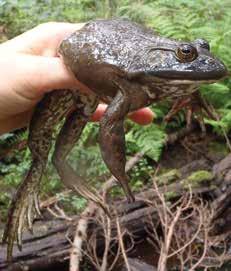
2 minute read
Fact or Fiction - Learning to Live with Bullfrogs
FACT OR FICTION -
LEARNING TO LIVE
Advertisement
WITH BULLFROGS
The American Bullfrog (Lithobates catesbeianus) is a native amphibian species of Eastern North America. This large frog occurs as a nonnative and invasive species in many places around the world a result of purposeful and accidental introductions. For example, numerous populations became established as a result of released individuals from unsuccessful frog-leg farms. The highly aquatic Bullfrog occurs throughout the Pacific Northwest, including eastern and southern Vancouver Island and the south coast of mainland British Columbia. The media have presented the Bullfrog as a “voracious predator” that is significantly impacting native wildlife species including amphibians, reptiles, small mammals, fish, and birds. This has led to a lot of public concern and fear, to the point that
some people have inadvertently killed native amphibians in an effort to remove what they thought were Bullfrogs in their garden ponds. Efforts to eradicate Bullfrogs in Europe, South America, and in the U.S. have largely been unsuccessful and extremely costly. An estimate of the cost to eradicate the Bullfrog from British Columbia ranges from $3.7 to $37 million dollars per year. The Bullfrog issue is a complex interaction Elke is a self employed biologist between habitat loss and degradation, nonwith 25+ years native fish species, and human experience interventions on a number of studying amphibian levels. Bullfrogs are introduced populations. and spread primarily via humans, including children catching and releasing tadpoles, and frogs and tadpoles sold at pet stores and online. Although not ideal, native amphibians can cohabitate with Bullfrogs where ephemeral wetland and upland forest habitats are protected and where naturally complex wetlands exist. Concerned citizens can do a number of things to protect native species from Bullfrogs, but the expectation that full eradication can be reached is not realistic. We can protect wildlife by learning to live with Bullfrogs where they are fully established, while focusing on protecting natural wetland habitats, removing Bullfrogs in isolated locations where the probability of re-introduction is low, and controlling the spread of Bullfrogs into new areas. Adult Bullfrogs can reach a larger size in the mild climate of the Pacific Northwest compared to their native eastern North America range An enchanting and evocative look at the unique relationship between a solitary, island-dwelling wolf and a renowned wildlife photographer. A lone wild wolf lives on a small group of uninhabited islands in British Columbia’s Salish Sea, surrounded by freighter, oil tanker and other boat traffic and in close proximity to a large urban area. His name is Takaya, which is the Coast Salish First Nations people’s word for wolf.
Cheryl Alexander studied and documented this unique wolf for years, unravelling the many mysteries surrounding his life. Her documentation of Takaya’s journey, his life on the islands and the development of their deep connection is presented alongside a stunning collection of her photography. Through journal entries, interviews, and a stunning collection of photography, Takaya: Lone Wolf addresses a number of profound questions and tells a story that is certain to inspire, enlighten, and touch the heart. It is the story of a wild animal, alone yet at peace.





